Is there a chance The Ultimate MK 3 to be the WAVENET version ? ( xbox 360v )
2D Kombat Klassics
Pages: 1
Is there a chance The Ultimate MK 3 to be the WAVENET version ? ( xbox 360v )
About Me
TheProphet, GGs my friend. Give'em Hell.
0
I am hoping there is, but at the same time it would probably be considerably more difficult to emulate since Wavenet's got two mainboards, both with relatively complicated CPUs. Thats an unusual setup for an arcade.
If they still have the source code, they don't need to emulate it, they can just do a perfect port. Honestly, I don't see why they just didn't do that with MAT, that way they could have avoided the flickering shadow problem, and also not have to worry about the memory limit for UMK3 since they could have just compressed the textures (sprites) into the video memory on PS2/XBOX.
About Me
TheProphet, GGs my friend. Give'em Hell.
0
Porting = more difficult = more money and they have always stayed away from that.
Considering how advanced some of the features of XBox Live can be, it would make more sense to do a port of the game. I doubt they'd ever get a Perfect port since that rarely (if ever) happens. The closest thing to a perfect port is usually when a game is ported from an arcade system to its corresponding console system (i.e. Naomi->Dreamcast).
Damn I hope they get this right...
Considering how advanced some of the features of XBox Live can be, it would make more sense to do a port of the game. I doubt they'd ever get a Perfect port since that rarely (if ever) happens. The closest thing to a perfect port is usually when a game is ported from an arcade system to its corresponding console system (i.e. Naomi->Dreamcast).
Damn I hope they get this right...
The reason why ported games were usually not accurate in the past was simply because the arcade hardware was more powerful than the home system hardware. Home systems didn't have enough memory to hold all the sprites. And even if they did, the resolution that was used in the arcade was a strange resolution, and back then video cards/home systems couldn't scale the screen smoothly, so they needed to scale down the sprites, and also modify the way characters move and stuff because they were using a smaller scale of pixels (which would change the way combination hits would work in some cases).
Emulation itself is actually much harder than taking the source code of something and porting it, especially when the thing that you are porting is on a system thats 10+ years old. You need to study all of the hardware components, and make sure you emulate them 1:1 so that there are absolutely no glitches, and that can also be very slow (which is why some of the versions of MAT have slow downs on certain systems). Everything down to all floating point calculations have to give the exact same results on the original hardware as it does on emulated hardware (which is a huge headache and a huge slow down).
Now, if the source code is purely in machine language, than perhaps it would take a while for them to go line by line and port it to C, but it should still be a faster process than emulating a whole hardware system. And it's a more rewarding process as well. If they ended up doing a proper port, then they could easily add online components, add new secrets, remake MK Trilogy with arcade quality graphics, etc.
Emulation itself is actually much harder than taking the source code of something and porting it, especially when the thing that you are porting is on a system thats 10+ years old. You need to study all of the hardware components, and make sure you emulate them 1:1 so that there are absolutely no glitches, and that can also be very slow (which is why some of the versions of MAT have slow downs on certain systems). Everything down to all floating point calculations have to give the exact same results on the original hardware as it does on emulated hardware (which is a huge headache and a huge slow down).
Now, if the source code is purely in machine language, than perhaps it would take a while for them to go line by line and port it to C, but it should still be a faster process than emulating a whole hardware system. And it's a more rewarding process as well. If they ended up doing a proper port, then they could easily add online components, add new secrets, remake MK Trilogy with arcade quality graphics, etc.
About Me
TheProphet, GGs my friend. Give'em Hell.
0
I think in any game where they have source in a high level language you are probably right, but in the cases of most of these arcade games (the older ones that is), the development was very much machine code based, which is why in games like MK, they actually develop it to the point where they can edit the game on a mockup arcade machine that stores their changes. In different vids of the development you can actually see them working with assembly and editting character movements on screen on the machine.
I think a good example of High level source leading to fantastic ports would be GGXX for PS2 and PC. The PS2 version is very good (I don't know it well enough to nitpick details where they made mistakes but AFAIK its very good) and then the PC port of the PS2 game is spot on, exactly like the PS2 game.
I think if porting of the arcades was easier, they would have done it with MAT2 MK2 and MK3, since Xbox and PS2 could have easily handled MK2 or MK3 if it was ported to them. Instead it was emued and we get crap.
I think a good example of High level source leading to fantastic ports would be GGXX for PS2 and PC. The PS2 version is very good (I don't know it well enough to nitpick details where they made mistakes but AFAIK its very good) and then the PC port of the PS2 game is spot on, exactly like the PS2 game.
I think if porting of the arcades was easier, they would have done it with MAT2 MK2 and MK3, since Xbox and PS2 could have easily handled MK2 or MK3 if it was ported to them. Instead it was emued and we get crap.
All I know is that sometimes Midway doesn't handle their ports very well. I know that MK Trilogy wasn't an in-house development, but I don't know how they let that game pass quality control. The Pit had corrupted graphics, wrong music was being played on many stages, there was no "finish him/her" music, etc. I wouldn't be surprised if the team that ported MAT was just as bumbling in their ability to port games.
By not being able to port their franchise game after all these years shows how "great" Midway's programmers are. In fact, sometimes I think it may be better that they emulated the game because it gives them less chance to bungle up the actual game mechanics (take a look at MK:Advance).
Look at another series like Street Fighter, *all* of their games were perfect ports to the PSX, and now they are giving perfect ports to PS2/Xbox with netplay.
By not being able to port their franchise game after all these years shows how "great" Midway's programmers are. In fact, sometimes I think it may be better that they emulated the game because it gives them less chance to bungle up the actual game mechanics (take a look at MK:Advance).
Look at another series like Street Fighter, *all* of their games were perfect ports to the PSX, and now they are giving perfect ports to PS2/Xbox with netplay.
About Me
TheProphet, GGs my friend. Give'em Hell.
0
The signs point to emulation being cheaper/easier/faster then porting in the case of MAT2. Take a look at processor emulation like for 68K (or grab one of the .c files out of mame), its not all that daunting. It seems kinda fun actually.
And the Street Fighter Alpha series for PSX is far far far from a perfect port.
And the Street Fighter Alpha series for PSX is far far far from a perfect port.


About Me
- Your Source for UMK3 Competition -
When something better than UMK3 comes out, I'll let you all know, because it still hasn't happened yet.
0
SFA3 for PSX has frame cutting, and gameplay property errors all over the place, ie: Dhalsim is more powerful on PSX than Arcade, not to mention they added a bunch of characters which went into the Upper Naomi version.
"SFA3 for PSX has frame cutting, and gameplay property errors all over the place, ie: Dhalsim is more powerful on PSX than Arcade, not to mention they added a bunch of characters which went into the Upper Naomi version."
I think you are losing sight of what I meant by arcade perfect port. The game still looks and plays as Capcom intended it to be. Those changes you made were all intentional (adding characters, rebalancing power of characters). But they did not end up reducing the quality of the graphics (resolution is still the custom resolution used in the arcades-- yes there are a few frames of animation missing for each character, but they are not very noticable as compared to the lower resolution scaling thats predominant in the Mortal Kombat PC/PSX ports-- and the DC version had no animations missing). For me, if it was between the Arcade version or the PSX, I'd rather play the PSX version (because of the extra characters, modes), which is just a testament to the quality of the PSX version. When it comes to MK, its the opposite, you'd rather play the arcade version than the home versions because the home versions almost always have something wrong with them.
Now I realize that one thing that SFA3 had going for it was that all characters were flat-shaded, so it was a little be easier to compress, but you have to admit, they really pushed the PSX to the limit with that game.
I think you are losing sight of what I meant by arcade perfect port. The game still looks and plays as Capcom intended it to be. Those changes you made were all intentional (adding characters, rebalancing power of characters). But they did not end up reducing the quality of the graphics (resolution is still the custom resolution used in the arcades-- yes there are a few frames of animation missing for each character, but they are not very noticable as compared to the lower resolution scaling thats predominant in the Mortal Kombat PC/PSX ports-- and the DC version had no animations missing). For me, if it was between the Arcade version or the PSX, I'd rather play the PSX version (because of the extra characters, modes), which is just a testament to the quality of the PSX version. When it comes to MK, its the opposite, you'd rather play the arcade version than the home versions because the home versions almost always have something wrong with them.
Now I realize that one thing that SFA3 had going for it was that all characters were flat-shaded, so it was a little be easier to compress, but you have to admit, they really pushed the PSX to the limit with that game.
About Me
TheProphet, GGs my friend. Give'em Hell.
0
Basically though, its not an arcade perfect port because the graphics are not that close to the arcade.
On the other hand, SFA3^ for dreamcast is a fantastic port, great graphics, arguably great gameplay (fans of the arcade often dislike this version because it is more balanced i.e. weakened Vism) but that is to be expected since it was ported from an arcade system to its corresponding console system, same architecture and layout.
On the other hand, SFA3^ for dreamcast is a fantastic port, great graphics, arguably great gameplay (fans of the arcade often dislike this version because it is more balanced i.e. weakened Vism) but that is to be expected since it was ported from an arcade system to its corresponding console system, same architecture and layout.
I know I'm grasping at straws and going OT here but...  ...
...
SFA3 is pixel perfect. The exact same sprites that are used in the arcade are used at home. There is *some* animation missing (mostly on bigger characters like Zangief), but you'd only know it from looking at it in slow motion. I have both the PSX and DC versions of SFA3 (although its been ages since I've played my dreamcast), and yes, on TV the PSX version looks a little more grainy, but that's just because of the way the PSX draws the screen vs. the way the DC draws the screen.
But hey, if you can notice the animation difference, then more power to ya!
I think I lost the point I wanted to make from this anyways
SFA3 is pixel perfect. The exact same sprites that are used in the arcade are used at home. There is *some* animation missing (mostly on bigger characters like Zangief), but you'd only know it from looking at it in slow motion. I have both the PSX and DC versions of SFA3 (although its been ages since I've played my dreamcast), and yes, on TV the PSX version looks a little more grainy, but that's just because of the way the PSX draws the screen vs. the way the DC draws the screen.
But hey, if you can notice the animation difference, then more power to ya!
I think I lost the point I wanted to make from this anyways


About Me
- Your Source for UMK3 Competition -
When something better than UMK3 comes out, I'll let you all know, because it still hasn't happened yet.
0
We understand what you are trying to say, but I don't really think it applies. Can you post a comparison pixel to pixel for SFA3 Arcade and PSX?
Okay... lets see if I know how to link images properly  (sorry to 56kers for the amount of pics)
(sorry to 56kers for the amount of pics)
First of all, here's a gallery of the SFA3 Arcade version:
http://www.vgmuseum.com/images/arcade3/02/261.html
Heres screenshots of the PSX version:
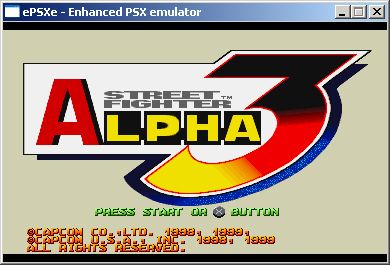
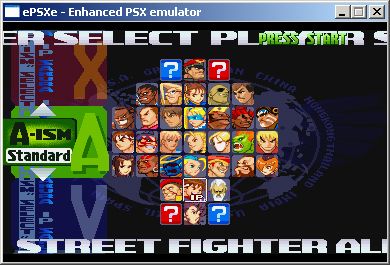
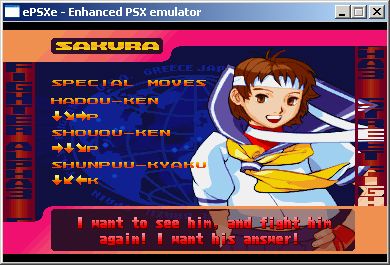
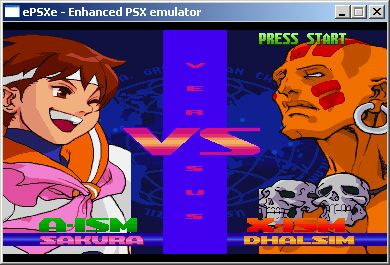
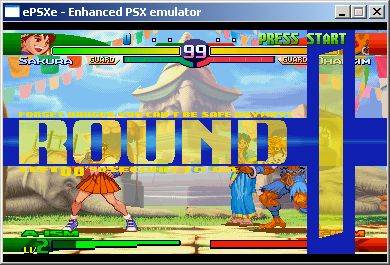
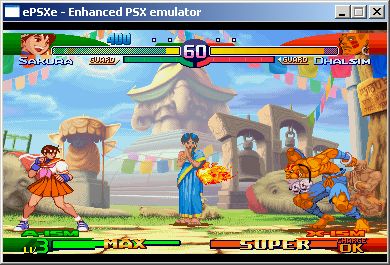
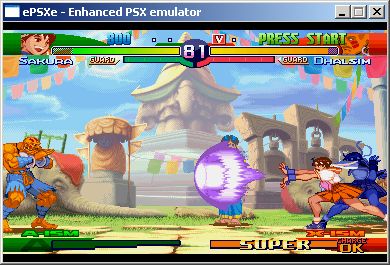
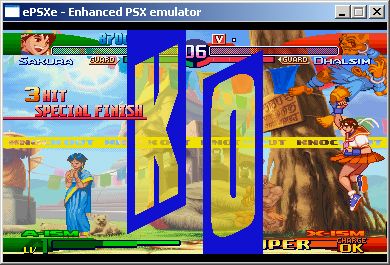

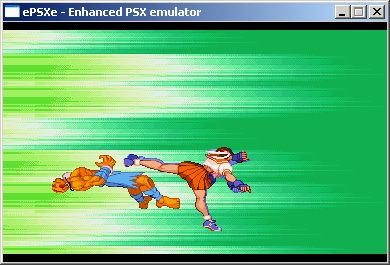
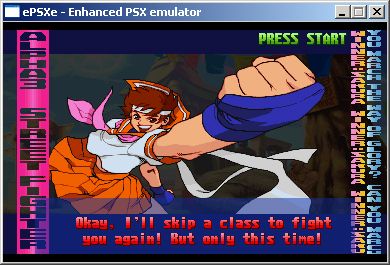

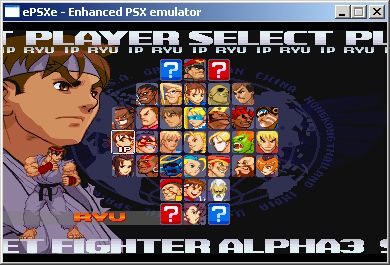

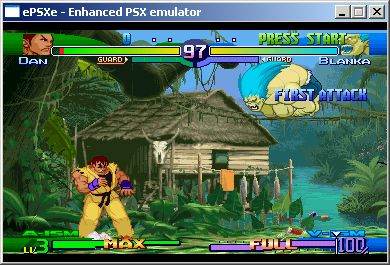
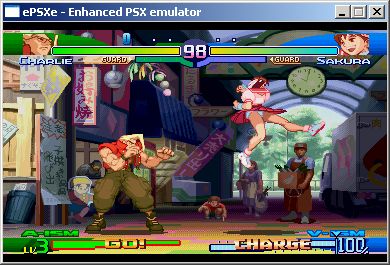
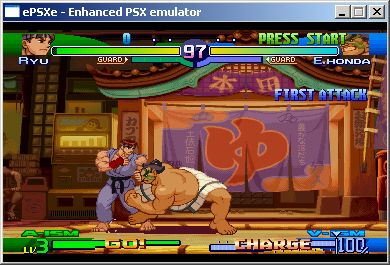
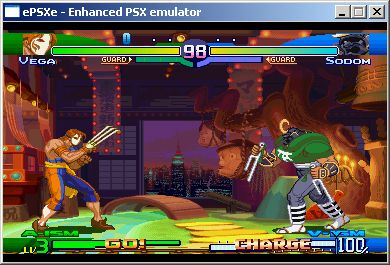
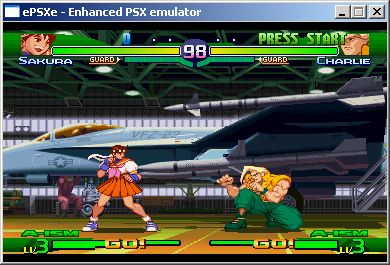
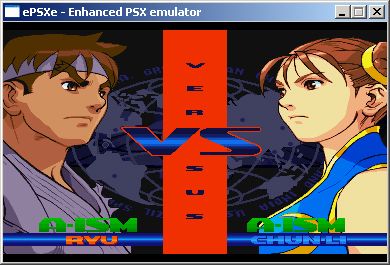
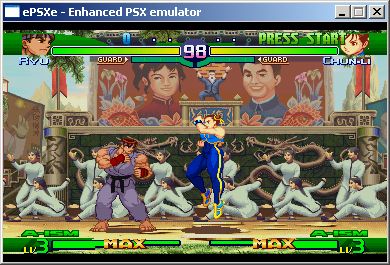
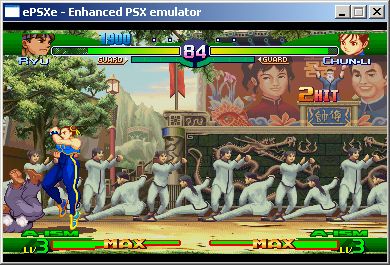
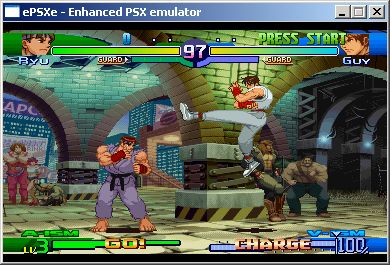
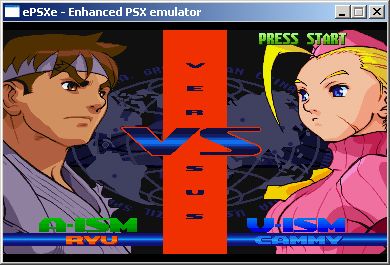
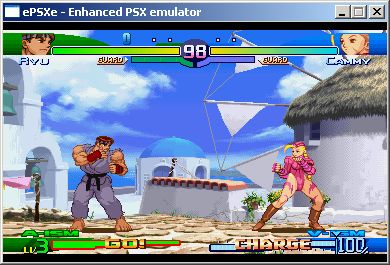
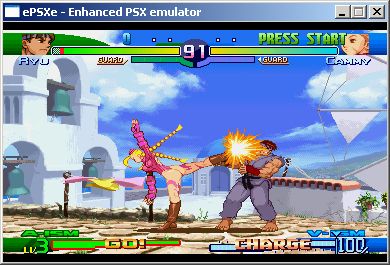
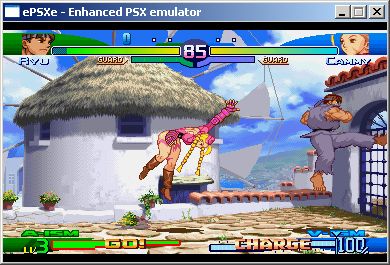
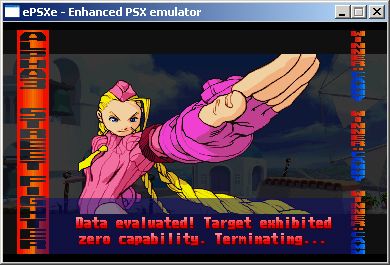

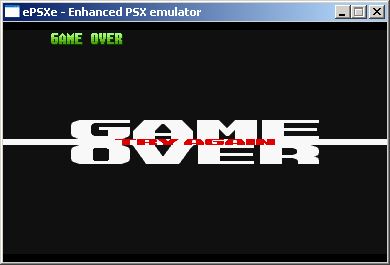
You can also view the PSX gallery here
Major differences between the PSX and Arcade version? The Arcade version runs at a 384x224 resolution, the PSX version runs at a 384x240 resolution (although you can see that nothing is really drawn in that extra space). Theres a new profile screen in the PSX version (shows a different picture which isn't in the arcade version. Transparencies are simulated in the Arcade version using alternating dotted pixels while on the PSX version they are actual transparencies. In the Arcade version, Karen has a similar background as Sakura's, but in the PSX version she has a different background. The life bars are slightly smaller on the PSX version and the face pictures of each character are brought in closer from the edge of the screen. There are other differences (like more characters), but just thought I'd mention some discrepencies you'd notice in that set of screenies.
First of all, here's a gallery of the SFA3 Arcade version:
http://www.vgmuseum.com/images/arcade3/02/261.html
Heres screenshots of the PSX version:






























You can also view the PSX gallery here
Major differences between the PSX and Arcade version? The Arcade version runs at a 384x224 resolution, the PSX version runs at a 384x240 resolution (although you can see that nothing is really drawn in that extra space). Theres a new profile screen in the PSX version (shows a different picture which isn't in the arcade version. Transparencies are simulated in the Arcade version using alternating dotted pixels while on the PSX version they are actual transparencies. In the Arcade version, Karen has a similar background as Sakura's, but in the PSX version she has a different background. The life bars are slightly smaller on the PSX version and the face pictures of each character are brought in closer from the edge of the screen. There are other differences (like more characters), but just thought I'd mention some discrepencies you'd notice in that set of screenies.
Edit: Looks like vgmuseum doesn't like direct links to their images, but if you view the gallery HERE and then refresh this page, the pics from the arcade version should appear here (at least it does in firefox). Otherwise you'll just be seeing the PSX version pics again without the arcade counterpart
Here's some direct comparisons between the Arcade version and the PSX version (sorry to 56kers!):
Title screen


Character Select


Profile


Versus


Round 3


KO


Cammy's Stage


Cammy Wins


Continue


Here's some direct comparisons between the Arcade version and the PSX version (sorry to 56kers!):
Title screen


Character Select


Profile


Versus


Round 3


KO


Cammy's Stage


Cammy Wins


Continue




About Me
- Your Source for UMK3 Competition -
When something better than UMK3 comes out, I'll let you all know, because it still hasn't happened yet.
0
So how did they get the game to actually play? All the graphics used are original, no resizing or touch ups, how will their method of running the game be usable, or worth it for them at least over emulation? What is the difference between dumping the raw data and running it on different hardware (being a home system) than dumping the raw data onto a computer and creating software to run it? Anyway you slice it, they are going to use the original graphics, sounds, etc, the difficult part is getting it to play right (with no garbling sounds because of the sync problems in earlier, smaller versions of MAME.
"So how did they get the game to actually play? All the graphics used are original, no resizing or touch ups, how will their method of running the game be usable, or worth it for them at least over emulation? What is the difference between dumping the raw data and running it on different hardware (being a home system) than dumping the raw data onto a computer and creating software to run it? Anyway you slice it, they are going to use the original graphics, sounds, etc, the difficult part is getting it to play right (with no garbling sounds because of the sync problems in earlier, smaller versions of MAME."
The big difference for me is that with emulation, either you cut corners (which introduces inaccuracies in emulation), or you emulate it to perfection, but at CPU cost which would probably be a factor of 10 more than the original hardware that is being emulated.
In the case of MAT, they had to cut out sound emulation completely, and instead just used a wrapper which would play sound files (in the windows version, they used WMA files).
Theres also slowdowns (I personally have only played MK2 a little bit from MKSM, never played the PSP versions of MAT but I've read reviews which indicate this) which occur if the hardware can't keep up.
Slowdowns are a much bigger issue on consoles than on a PC, but they can still be one. If you have a slower computer sitting around which isn't fast enough to say, play MK3 on MAME, but probably would be fast enough to play MK3 from a direct port, you'd really want a native port. Now I know that a lot of developers don't consider PC's older than 3 years, but they'd open themselves to many more sales if they lowered the minimum requirements.
Also, it gives you inflexibility. It's easier to create netplay which works if you can use the source code; while netplay has been done with emulation, it's much laggier and it's not an ideal setup for a commercial game (with not really having a proper netplay interface, all it does is set 1 player to 1P and the other player to 2P-- ideally they would want to do stuff like add a king of the hill feature where all of your friends could join in a room and play, which wouldn't be possible with emulation).
A relatively minor note, but still important is that they could actually add features to the game. At this point, the games are relics unto themselves, so they probably wouldn't want to do that, but it's the reason why SFA3 was probably the best fighter on the PS1.
Finally, and most importantly IMO, UMK3 would have been possible on the current generation of consoles if they actually could play around with the source. They could easily add streaming of files which are not readily needed (stages, bio/versus screen pictures, etc) which would have freed up the memory to be able to fit UMK3 in. (Of course, I'm assuming memory was the reason why UMK3 didn't make it to MAT).
The big difference for me is that with emulation, either you cut corners (which introduces inaccuracies in emulation), or you emulate it to perfection, but at CPU cost which would probably be a factor of 10 more than the original hardware that is being emulated.
In the case of MAT, they had to cut out sound emulation completely, and instead just used a wrapper which would play sound files (in the windows version, they used WMA files).
Theres also slowdowns (I personally have only played MK2 a little bit from MKSM, never played the PSP versions of MAT but I've read reviews which indicate this) which occur if the hardware can't keep up.
Slowdowns are a much bigger issue on consoles than on a PC, but they can still be one. If you have a slower computer sitting around which isn't fast enough to say, play MK3 on MAME, but probably would be fast enough to play MK3 from a direct port, you'd really want a native port. Now I know that a lot of developers don't consider PC's older than 3 years, but they'd open themselves to many more sales if they lowered the minimum requirements.
Also, it gives you inflexibility. It's easier to create netplay which works if you can use the source code; while netplay has been done with emulation, it's much laggier and it's not an ideal setup for a commercial game (with not really having a proper netplay interface, all it does is set 1 player to 1P and the other player to 2P-- ideally they would want to do stuff like add a king of the hill feature where all of your friends could join in a room and play, which wouldn't be possible with emulation).
A relatively minor note, but still important is that they could actually add features to the game. At this point, the games are relics unto themselves, so they probably wouldn't want to do that, but it's the reason why SFA3 was probably the best fighter on the PS1.
Finally, and most importantly IMO, UMK3 would have been possible on the current generation of consoles if they actually could play around with the source. They could easily add streaming of files which are not readily needed (stages, bio/versus screen pictures, etc) which would have freed up the memory to be able to fit UMK3 in. (Of course, I'm assuming memory was the reason why UMK3 didn't make it to MAT).


About Me
- Your Source for UMK3 Competition -
When something better than UMK3 comes out, I'll let you all know, because it still hasn't happened yet.
0
DreemerNJ and i have discussed a lot of this over the past year or so. It's very disheartening the way they went about doing MAT, but ultimately it comes down to $$$. Whatever that company was who made MAT, they probably didn't have motivation to do things the right, or much less, best way, there's no other explanation as far as I can tell. Look at how much money they probably made for putting out that thing. A dishonest buck.
Pages: 1
© 1998-2025 Shadow Knight Media, LLC. All rights reserved. Mortal Kombat, the dragon logo and all character names are trademarks and copyright of Warner Bros. Entertainment Inc.






